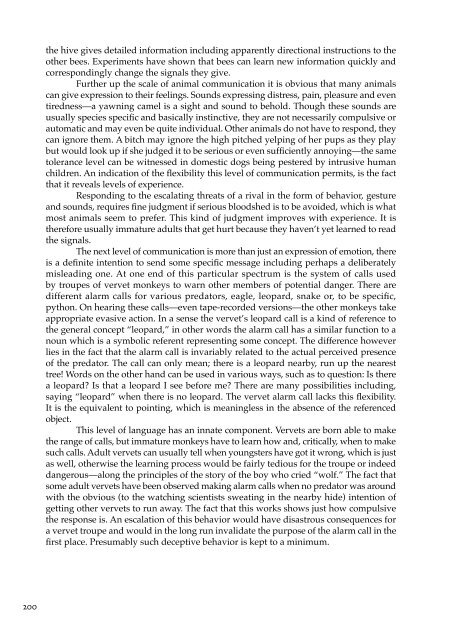The Spirit in Human Evolution - Waldorf Research Institute
The Spirit in Human Evolution - Waldorf Research Institute
The Spirit in Human Evolution - Waldorf Research Institute
Create successful ePaper yourself
Turn your PDF publications into a flip-book with our unique Google optimized e-Paper software.
200<br />
the hive gives detailed <strong>in</strong>formation <strong>in</strong>clud<strong>in</strong>g apparently directional <strong>in</strong>structions to the<br />
other bees. Experiments have shown that bees can learn new <strong>in</strong>formation quickly and<br />
correspond<strong>in</strong>gly change the signals they give.<br />
Further up the scale of animal communication it is obvious that many animals<br />
can give expression to their feel<strong>in</strong>gs. Sounds express<strong>in</strong>g distress, pa<strong>in</strong>, pleasure and even<br />
tiredness—a yawn<strong>in</strong>g camel is a sight and sound to behold. Though these sounds are<br />
usually species specific and basically <strong>in</strong>st<strong>in</strong>ctive, they are not necessarily compulsive or<br />
automatic and may even be quite <strong>in</strong>dividual. Other animals do not have to respond, they<br />
can ignore them. A bitch may ignore the high pitched yelp<strong>in</strong>g of her pups as they play<br />
but would look up if she judged it to be serious or even sufficiently annoy<strong>in</strong>g—the same<br />
tolerance level can be witnessed <strong>in</strong> domestic dogs be<strong>in</strong>g pestered by <strong>in</strong>trusive human<br />
children. An <strong>in</strong>dication of the flexibility this level of communication permits, is the fact<br />
that it reveals levels of experience.<br />
Respond<strong>in</strong>g to the escalat<strong>in</strong>g threats of a rival <strong>in</strong> the form of behavior, gesture<br />
and sounds, requires f<strong>in</strong>e judgment if serious bloodshed is to be avoided, which is what<br />
most animals seem to prefer. This k<strong>in</strong>d of judgment improves with experience. It is<br />
therefore usually immature adults that get hurt because they haven’t yet learned to read<br />
the signals.<br />
<strong>The</strong> next level of communication is more than just an expression of emotion, there<br />
is a def<strong>in</strong>ite <strong>in</strong>tention to send some specific message <strong>in</strong>clud<strong>in</strong>g perhaps a deliberately<br />
mislead<strong>in</strong>g one. At one end of this particular spectrum is the system of calls used<br />
by troupes of vervet monkeys to warn other members of potential danger. <strong>The</strong>re are<br />
different alarm calls for various predators, eagle, leopard, snake or, to be specific,<br />
python. On hear<strong>in</strong>g these calls—even tape-recorded versions—the other monkeys take<br />
appropriate evasive action. In a sense the vervet’s leopard call is a k<strong>in</strong>d of reference to<br />
the general concept “leopard,” <strong>in</strong> other words the alarm call has a similar function to a<br />
noun which is a symbolic referent represent<strong>in</strong>g some concept. <strong>The</strong> difference however<br />
lies <strong>in</strong> the fact that the alarm call is <strong>in</strong>variably related to the actual perceived presence<br />
of the predator. <strong>The</strong> call can only mean; there is a leopard nearby, run up the nearest<br />
tree! Words on the other hand can be used <strong>in</strong> various ways, such as to question: Is there<br />
a leopard? Is that a leopard I see before me? <strong>The</strong>re are many possibilities <strong>in</strong>clud<strong>in</strong>g,<br />
say<strong>in</strong>g “leopard” when there is no leopard. <strong>The</strong> vervet alarm call lacks this flexibility.<br />
It is the equivalent to po<strong>in</strong>t<strong>in</strong>g, which is mean<strong>in</strong>gless <strong>in</strong> the absence of the referenced<br />
object.<br />
This level of language has an <strong>in</strong>nate component. Vervets are born able to make<br />
the range of calls, but immature monkeys have to learn how and, critically, when to make<br />
such calls. Adult vervets can usually tell when youngsters have got it wrong, which is just<br />
as well, otherwise the learn<strong>in</strong>g process would be fairly tedious for the troupe or <strong>in</strong>deed<br />
dangerous—along the pr<strong>in</strong>ciples of the story of the boy who cried “wolf.” <strong>The</strong> fact that<br />
some adult vervets have been observed mak<strong>in</strong>g alarm calls when no predator was around<br />
with the obvious (to the watch<strong>in</strong>g scientists sweat<strong>in</strong>g <strong>in</strong> the nearby hide) <strong>in</strong>tention of<br />
gett<strong>in</strong>g other vervets to run away. <strong>The</strong> fact that this works shows just how compulsive<br />
the response is. An escalation of this behavior would have disastrous consequences for<br />
a vervet troupe and would <strong>in</strong> the long run <strong>in</strong>validate the purpose of the alarm call <strong>in</strong> the<br />
first place. Presumably such deceptive behavior is kept to a m<strong>in</strong>imum.
















